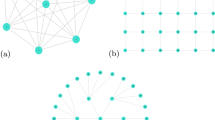Abstract
Cosmic string bearing energy-momentum tensor can cause spacetime bending and gravitation effect. Entanglement plays significant role in quantum communication and quantum cryptography. In this article, we examine the performance of semi-quantum secure direct communication (SQSDC) and its relation with entanglement affected by massless scalar field in the background of cosmic string spacetime. It is found that vacuum fluctuation, acceleration and nontrivial spacetime topology have profound effect on the fidelity and entanglement. Fidelity decreases fast to a fixed value and entanglement decays quickly with increasing acceleration and evolution time. When defect parameter \(\nu =1\) and atom is far away from the string, the evolution model restores to that of Minkowski spacetime. When atom is very close to the string, fidelity and entanglement are similar to that of Minkowski spacetime but related to topology defect parameter. For defect parameter \(\nu >1\), when acceleration is relatively small, fidelity and entanglement present oscillatory behavior for some time as atom-string distance increases. The results would shed light on quantum communication in curved spacetime.




Similar content being viewed by others
References
Shenoy-Hejamadi, A., Pathak, A., Radhakrishna, S.: Quantum cryptography: key distribution and beyond. Quanta 6, 1 (2017)
Huang, Z.M., Situ, H.Z.: Protection of quantum dialogue affected by quantum field. Quantum Inf. Process. 18, 37 (2019)
Iqbal, H., Krawec, W.O.: Semi-quantum cryptography. Quantum Inf. Process. 19, 97 (2020)
Boyer, M., Kenigsberg, D., Mor, T.: Quantum key distribution with classical Bob. Phys. Rev. Lett. 99, 140501 (2007)
Horodecki, R., Horodecki, P., Horodecki, M., Horodecki, K.: Quantum entanglement. Rev. Mod. Phys. 81, 865 (2009)
Rong, Z.B., Qiu, D.W., Zou, X.F.: Semi-quantum secure direct communication using entanglement. Int. J. Theor. Phys. 59, 1807 (2020)
Rong, Z.B., Qiu, D.W., Mateus, P., Zou, X.F.: Mediated semi-quantum secure direct communication. Quantum Inf. Process. 20, 58 (2021)
Huang, Z.M., Ye, Y.Y., Luo, D.R.: Simultaneous dense coding affected by fluctuating massless scalar field. Quantum Inf. Process. 17, 101 (2018)
Huang, Z.M.: Quantum teleportation in thermal fluctuating electromagnetic field. Int. J. Theor. Phys. 58, 383 (2019)
Huang, Z.M.: Quantum secret sharing affected by vacuum fluctuation. Quantum Inf. Process. 18, 88 (2019)
Huang, Z.M., Z.M.: He.Deterministic secure quantum communication under vacuum fluctuation. Eur. Phys. J. D 74, 176 (2020)
Exirifard, Q., Culf, E., Karimi, E.: Towards communication in a curved spacetime geometry. Commun. Phys. 4, 171 (2021)
Velenkin, A., Shellard, E.P.S.: Cosmic Strings and Other Topological Defects. Cambridge University Press, Cambridge (1994)
Saharian, A.A., Kotanjyan, A.S.: Repulsive Casimir-Polder forces from cosmic strings. Eur. Phys. J. C 71, 1765 (2011)
Vilenkin, A.: Cosmic strings as gravitational lenses. Astrophys. J. 282, L51 (1984)
Ford, L.H., Vilenkin, A.: A gravitational analogue of the Aharonov-Bohm effect. J. Phys. A: Math. Gen. 14, 2353 (1981)
Gorini, V., Kossakowski, A., Surdarshan, E.C.G.: Completely positive dynamical semigroups of N-level systems. J. Math. Phys. 17, 821 (1976)
Lindblad, G.: On the generators of quantum dynamical semigroups. Commun. Math. Phys. 48, 119 (1976)
Breuer, H.-P., Petruccione, F.: The Theory of Open Quantum Systems. Oxford University Press, Oxford (2002)
Vilenkin, A.: Gravitational field of vacuum domain walls and strings. Phys. Rev. D 23, 852 (1981)
Gradshteyn, I.S., Ryzhik, I.M.: Table of Integrals, Series, and Products, 7th edn. Academic, Orlando, FL (1980)
Wootters, W.K.: Entanglement of formation of an arbitrary state of two qubits. Phys. Rev. Lett. 80, 2245 (1998)
Huang, Z.M., Situ, H.Z.: Dynamics of quantum correlation and coherence for two atoms coupled with a bath of fluctuating massless scalar field. Ann. Phys. 377, 484 (2017)
Huang, Z.M., Zhang, W.: Quantum coherence behaviors for a uniformly accelerated atom immersed in fluctuating vacuum electromagnetic field with a boundary. Braz. J. Phys. 49, 161 (2019)
Acknowledgements
This work is supported by the National Natural Science Foundation of China (61871205), the Guangdong Basic and Applied Basic Research Foundation (2021A1515012623, 2021A1515012138, 2019A1515011166), and the Project of Department of Education of Guangdong Province (2019KTSCX188, 2020KTSCX132).
Author information
Authors and Affiliations
Additional information
Publisher's Note
Springer Nature remains neutral with regard to jurisdictional claims in published maps and institutional affiliations.
Appendix: Field correlation function
Appendix: Field correlation function
where \(\Delta \tau =\tau -\tau '\) and \(\displaystyle X=\frac{2}{r^{-2 \nu } \left[ -\frac{\cosh (a \Delta \tau )}{a^2}-\sqrt{\frac{1-\cosh (a \Delta \tau )}{a^2}} \sqrt{-\frac{\cosh (a \Delta \tau )}{a^2}+\frac{1}{a^2}+2 r^2}+\frac{1}{a^2}+r^2\right] ^{\nu }+1}-1\).
Rights and permissions
About this article
Cite this article
Huang, Z., Rong, Z., Zou, X. et al. Semi-quantum secure direct communication in the curved spacetime. Quantum Inf Process 20, 375 (2021). https://doi.org/10.1007/s11128-021-03316-5
Received:
Accepted:
Published:
DOI: https://doi.org/10.1007/s11128-021-03316-5




